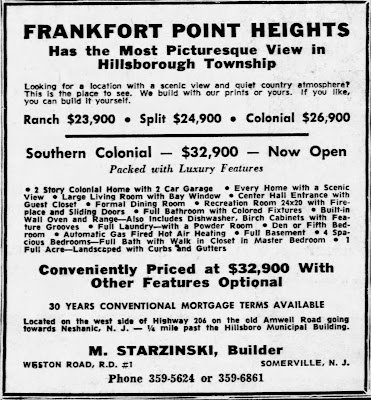If I had to nominate one year as the most tumultuous in the history of Hillsborough Township Schools it would be hard to find a better candidate than 1928. Trouble had been brewing for sixteen years and had been boiling over since at least 1925. Hillsborough Township had never adequately provided for the huge influx of students that came with the opening of the Johns Manville factory in the northeast corner of the municipality in 1912, and now they would have to answer for it.
 |
| Bloomingdale School, August 2017 |
 |
| Detail from the 1873 Hillsborough map showing Bloomingdale District 43 |
The state insisted that Hillsborough build a new eight-room brick school for Manville, plus add a four-room addition to School 1 (Main Street School). The story gets complicated from here, with a lot of business concerning improper referendums and illegally purchased land.
 |
| Bloomingdale School, July 2017 |
Much of the intrigue concerned board president William H. Hill - a 25-year member of the board who, according to the Courier News, bragged often of being "the guiding hand in the educational affairs of the township." He tried unsuccessfully to have a two-room school built at Blackwell's Mills - where he resided - to replace the century-old one-room school there.
 |
| Bloomingdale School interior, July 2017 |
After a summer spent sorting out legal problems, the school board met on November 8 to award contracts for a new eight-room school in Manville, a four-room addition to School 1, and a new four-room schoolhouse at Bloomingdale. Greasheimer Construction Company had the low bid for the Bloomingdale School: $24,192. Elling Brothers got the plumbing contract for a bid of $1,380; Burns, Lane, and Richardson won the heating contract for $3,820; C.F. Dean was awarded the electrical contract for $490. In total, Hillsborough Township's first modern school building cost less than $30,000. Construction took place throughout the winter, spring, and summer of 1929 on the lot just behind the one-room school, which was torn down that summer.
 |
| Students working on the school newspaper at Bloomingdale School, 12 April 1950 Courier News |
More than 150 people attended a reception for the new "Central School" soon after it opened in September 1929. All hailed the school for its thoroughly modern facilities. The pairs of classrooms at the left and right of the building could be opened up and combined to make larger rooms for activities, and, indeed, the school hosted many gatherings of Somerset County school employees during its first years.
 |
| The rear of Bloomingdale School, July 2017 |
Each of the four rooms housed two grades. May Huff was the first principal and taught grades 7 and 8. Helen Nevius taught 5 and 6, Estelle Walker taught 3 and 4, and Mary Skillman taught grades 1 and 2. The school was in regular use until 1950 when the consolidated school (HES) was built next door. After that, it became an annex for HES in times of increased enrollment and was also used on an emergency basis throughout the fifties and sixties.
Today the building houses the school's maintenance and transportation offices, as well as providing additional office space for other departments.


































